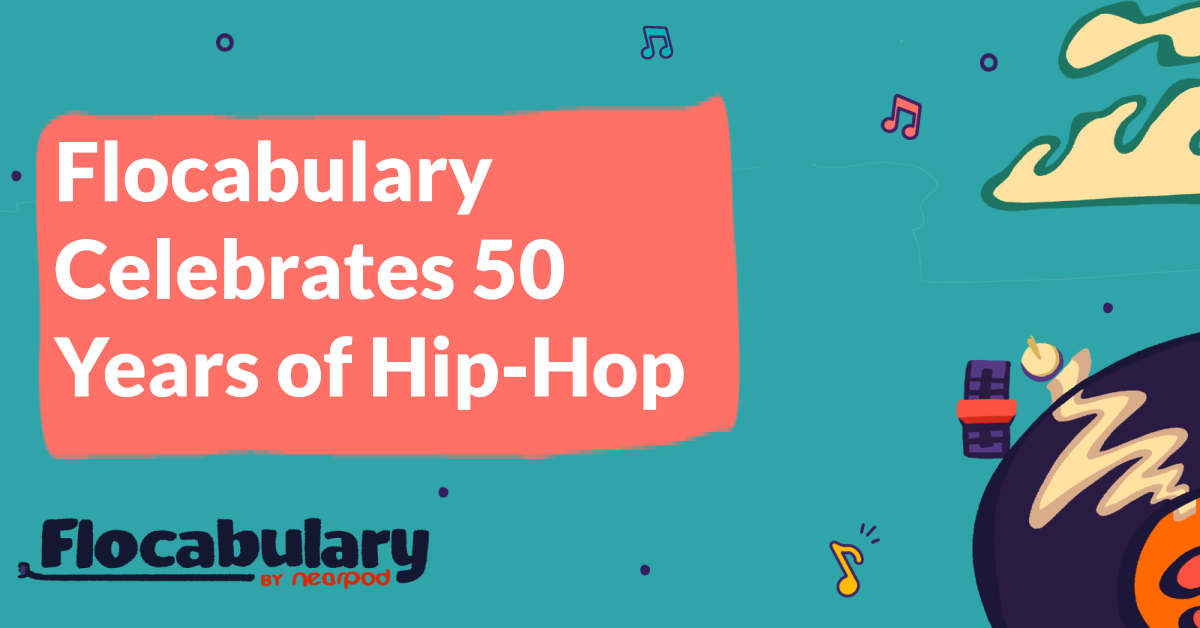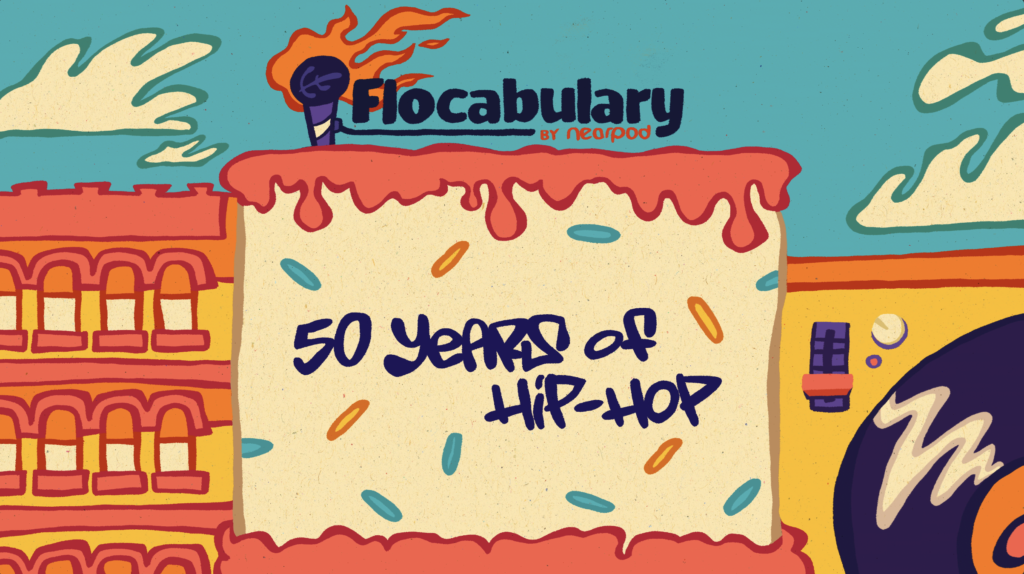
Celebrate 50 Years of Hip-Hop
To celebrate hip-hop’s 50th anniversary, Flocabulary is releasing a five-part “50 Years of Hip-Hop” video series throughout the week of August 7-11. Each day of the week, a new section of the song will be posted, building up to a full song and an explainer video to be released on Thursday, August 10th, in the evening. We will update this blog post daily with each section, so be sure to bookmark this page and check back as the week progresses!
When is the 50th anniversary of hip-hop, and why should it be celebrated?
August 11, 2023, marks 50 years since hip-hop was born. On this date in 1973, DJ Kool Herc hosted a “Back to School Jam” at 1520 Sedgwick Avenue in the Bronx. Using two copies of the same record and two turntables, Herc played instrumental breaks of songs over and over. When the break finished on one turntable, he quickly switched the signal to the other to play it again. This created a loop of music that gave “break boys” and “break girls” more time to dance. It also gave Herc a rhythmic canvas for his announcements on the mic—a stylistic approach to hosting that opened the door for what we now know as rapping. Hip-hop was born.
Here at Flocabulary, we owe everything to that party in the Bronx, so to celebrate hip-hop’s 50th anniversary, we’ve decided to tell the story of hip-hop the best way we know how: through hip-hop. Over the course of the week ending on August 11th, we will be releasing a five-part history of hip-hop piece-by-piece. This will all lead up to Thursday, August 10th, when we will release the full song on Flocabulary. We’ll also release a “50 Years of Hip-Hop Unpacked” explainer video hosted by one of our Flocabulary rappers.
Join us for our Youtube Live on August 7th at 5 pm ET as Flocabulary celebrates 50 years of hip-hop! 🔥
Captivate students and make learning experiences memorable and interesting. Sign up below to access the Flocabulary activities and lessons shared in this blog post!
Hip-hop history

Condensing 50 years of history into a single song is a tall task. Our team has spent the last few months researching, working with lyricists, recording verses, and creating visuals to celebrate this important occasion. Still, we could never claim to have covered everything. What we have created is a timeline and narrative of major milestones in the development, growth, and evolution of hip-hop culture.
Our history of hip-hop starts with its origins in the 1970s as well as the formation of hip-hop’s five pillars. While hip-hop may be used interchangeably with rap today, MCing is just one part of the full picture. The five pillars comprising hip-hop are DJing, break dancing, MCing, graffiti, and knowledge—knowledge of self, surroundings, and hip-hop’s history. Through these key aspects of hip-hop, the culture spread—at first from the Bronx to the rest of New York City, then later throughout the US and eventually the world.
At Flocabulary, it’s important to us to celebrate hip-hop in its entirety. While rapping and music production are most obviously related to our content, our connection to the other pillars flows through. Our video visuals and art are directly inspired by the music they’re matching—much like the close relationship between music and graffiti. It’s our sincere hope that at least some of our songs get students dancing, and of course, it all comes back to knowledge. This is why for hip-hop’s 50th anniversary, it’s only right we celebrate what we love so much and share the story of hip-hop as best we can.
Part 1: Origins (1973-1979)
Throughout the mid-1970s, DJ Kool Herc’s techniques spread to house parties and outdoor gatherings across New York City. Young Black and Latine people began shaping the five pillars. DJs like Grandmaster Flash and Grand Wizzard Theodore expanded upon Herc’s style, while MCs like Coke La Rock and members of groups like the Furious Five and Cold Crush Brothers rocked the mic. Breakbeats dubbed onto cassettes helped spread hip-hop, allowing MCs, b-boys, and b-girls to show their skills in school yards and neighborhood streets. At the time, MCing was strictly a live, in-person experience—a fact that would soon change when hip-hop caught the attention of the music industry.
Part 2: On Wax (1979-1987)
In 1979, the first commercially released hip-hop record came out: “Rapper’s Delight” by Sugarhill Gang. The song charted in the Top 40, pushing the genre into the spotlight and MCs into the studio. Early ’80s dance tracks like Kurtis Blow’s “The Breaks” were complemented by socially conscious songs like “The Message” by Grandmaster Flash and the Furious Five. Movies like Wild Style, Style Wars, and Beat Street showcased hip-hop culture to a widening audience.
Eventually, looped breaks were replaced by drum machines and synthesizers as the old school gave way to the new school in the mid-’80s. Artists like Run DMC, LL Cool J, The Beastie Boys, and Public Enemy became rap celebrities, while producers like Rick Rubin and The Bomb Squad embraced sampling like never before.
Part 3: Expansion (1987-1997)
By the late ’80s, hip-hop had spread globally. Women MCs and acts from outside New York stepped into the spotlight, and a major shift toward the West Coast came with NWA, whose aggressive style spawned gangsta rap and a new set of influential artists.
Back east, rappers were pushing lyrical boundaries. Changing production techniques brought forth new sounds in the early ’90s, ranging from gritty and grimy to playful and afrocentric—and everything in between.
Mainstream artists became A-list celebrities in the mid-’90s, like Diddy and Jay-Z on the East Coast, and Dr. Dre on the West. Displays of wealth increased alongside music video budgets as a rivalry between coasts developed—one that led to the death of both Tupac and the Notorious B.I.G.
Part 4: Commercial Success (1997-2007)
By the late ’90s, hip-hop was the best-selling genre in the US, with an increasingly White and suburban audience. Hip-hop’s musical and visual style was everywhere as a new region rose to prominence: the South. Southern artists added bounce to the genre with innovative cadences and a distinct production style.
The early and mid-2000s ultimately became an era of super producers. Dr. Dre signed Eminem and 50 Cent, and producers like Timbaland, Kanye West, and the Neptunes worked with an array of talented MCs. At this point, hip-hop was a fully commercial product. Some artists were just as well known for their movie roles or business ventures as they were for their music. Many underground acts still earned acclaim, but hip-hop was big business.
Part 5: The Internet (2007-2023)
As the Internet became a part of daily life and piracy threatened the music industry, commercial hip-hop sales slipped. Consumer recording technology rivaled professional studios and artists released their own music online. By the late-2000s, social media and file sharing introduced a new set of popular artists to a global audience. In the streaming era, hip-hop has regained commercial prominence, with the genre’s global appeal becoming clearer than ever.
Hip-Hop in the classroom
In many ways, the phrase “educational hip-hop” is unintentionally redundant. Hip-hop is inherently educational. MCs are creative writers who analyze their surroundings and present information, DJs and producers work with technology to bend audio to their will, dancers express themselves through movement, and graffiti artists do the same visually. All of this is in service of the fifth pillar of hip-hop: knowledge. We learn about ourselves and the tools we use when we make and work with art.
This is why hip-hop fits so seamlessly into a school environment. Not only is it familiar and engaging to so many students, but it’s also a powerful pedagogical tool. Hip-hop education and hip-hop pedagogy are two different things. Hip-hop education is learning about hip-hop—its history, current state, and how it’s created.
Hip-hop pedagogy is using hip-hop as a vehicle to teach other subjects—for example, learning about the French Revolution through a hip-hop song or having students write their own lyrics about photosynthesis. Although the 50 Years of Hip-Hop videos you just watched were hip-hop education via hip-hop pedagogy, most of Flocabulary’s content uses hip-hop to teach varying subjects—in other words, hip-hop pedagogy.
Research shows hip-hop songs have 2-3 times more words than songs in other genres. This makes hip-hop the perfect format to teach academic vocabulary. Students are exposed to vocabulary terms multiple times in context using a genre that promotes recall. Within each Flocabulary lesson, our curriculum team selects key tier 2 and tier 3 vocabulary terms that are not only included in the video but also throughout other lesson activities like Read and Respond. Students are even given the opportunity to write their own rhymes using those vocabulary terms in Lyric Lab. All of this vocabulary repetition builds reading comprehension skills. Research also suggests students must know over 95% of words in a text to comprehend what’s being communicated fully. Since vocabulary plays such a major role in comprehension—a crucial skill across the curriculum—a wordy, sticky genre like hip-hop makes perfect sense.
50 Years and Counting
50 years in, hip-hop has changed the world. From DJ Kool Herc at 1520 Sedgwick Avenue to Jay-Z selling out Madison Square Garden to Kendrick Lamar winning a Pulitzer Prize, hip-hop has undergone countless evolutions. 50 years may sound like a lot, but hip-hop is still growing. While the focus is so often on the music, it’s important to remember that hip-hop is primarily a culture—a way of living and being. What was created by young Black and Latine people in New York City is still alive today and still evolving under the care of those who love it.
Whether hip-hop is a cornerstone of your approach to teaching or you have yet to introduce it into your classroom, 2023 is as great a year as any to familiarize (or re-familiarize) yourself with its power as a teaching tool. Why not start with a look back at hip-hop’s first 50 years?
Bring the power of Flocabulary to your school!
